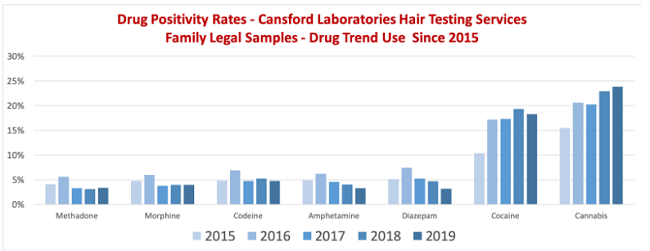CANSFORD LABS
Drug use in UK family law cases: Our 6-month report for 2019
on Oct 15, 2019
Cansford Labs is not short of data here in the UK. Every year, we conduct thousands of drug tests in sectors ranging from the workplace to social care to criminal law, allowing us to explore current trends in drug and alcohol use, and compare substance misuse in different social contexts.
In a recent article, we explored the substances that we detect most frequently in workplace testing programmes. Now, it’s time to take a look at our tests for family law cases: which substances do we see the largest number of positive results for, and do we know why?
The most commonly detected drugs in family law cases
 Individuals in family law cases may not expect a test to be sprung on them. And even if they do, they may not realise that hair drug and alcohol testing covers not just in-the-moment use, but will show their substance use over the last several months.
Individuals in family law cases may not expect a test to be sprung on them. And even if they do, they may not realise that hair drug and alcohol testing covers not just in-the-moment use, but will show their substance use over the last several months.
The substances that we detect the most frequently in family law cases have not changed. Cannabis takes the top spot, while cocaine is second, with these two substances alone making up over 40% of the positive samples we tested last year.
Trends we see in our own data
Cocaine usage amongst the general population is on the rise, which explains the trends we see in our own data. However, the same Home Office data reveals that the percentage of the adult population using cannabis has remained relatively flat in recent years - so why are we seeing positivity rates increase?
Middle-class parents, it’s claimed, are smoking joints with their children because they’d rather they experiment at home. A study has also shown that it’s easier for young people to buy cannabis than alcohol - particularly with the rise of dealers advertising on social media platforms. And if it’s easier for young people, that means it’s easier for the entire population. This ease of purchase, combined with the destigmatisation of cannabis as it becomes legalised in more places across the globe, may explain why usage is so high in family law cases.
The high levels may also be a result of circumstance. Generally, drug tests will be conducted in family law only if there is a history of usage, or suspected current usage. For this reason, it’s likely that the number of positive results will be greater than in workplace testing programmes.
Why cannabis and cocaine are on the rise
Cannabis
Cannabis remains the most widely used illegal recreational drug in the UK. It is often seen as a young person’s drug, but reports suggest otherwise. According to Home Office statistics on drug use (produced in 2018), 7.2 per cent of adults aged 16 to 59 have used cannabis in the last year.
While the UK has a long history of importing cannabis resin, particularly from North Africa, the home grown market expanded significantly over the course of the 2000’s. A 2012 report from the Association of Chief Police Officers found that herbal cannabis cultivated in farms, often located in rented properties and commercial units, now makes up around 70 to 80 percent of the commercial supply. Over 1.1 million plants with an estimated street value of £207 million were recovered during the 2011/2012 survey period.
Researchers requested data from Public Health England (PHE) on the number of people who had accessed drug treatment services in England and Wales for cannabis use – alone or with other substances – over the 10-year period from 2005/06 to 2015/16. They looked at how numbers had changed, and the spread by age and gender. The main finding was that the number of over-40s seeking treatment had more than doubled over the past 10 years for cannabis-related problems – rising from 471 to 1,008 and from 27,092 to 64,195 for treatment for any drug.
There have also been a lot of changes to the usual structure of cannabis since the 1970s. The amount of THC in marijuana—the chemical responsible for the drug’s potency—has increased dramatically in recent decades. In the mid-1990s, the average THC content of confiscated weed was roughly 4 percent. By 2014, it was about 12 percent, with a few samples containing THC levels as high as 37 percent.
Cocaine
Like cannabis, cocaine has become easier to source, cheaper to buy and is available in purer forms than it used to be. According to a report released in 2018, the number of people taking cocaine is at its highest in a decade: an estimated 875,000 people in England and Wales, aged 16 to 59, were found to have used the drug in the last 12 months. That’s around 2.6 per cent of the country’s population.
As cocaine has seeped into wider society, so too has the number of people facing health complications from its use grown. According to the Office for National Statistics, there were 432 deaths related to cocaine in England and Wales in 2017 – a jump from 371 a year before, and 112 in 2011. Fatalities often come from heart failure or strokes.
Hospital admissions for mental health disorders
Hospital admissions for mental health disorders linked to cocaine have almost trebled in the past decade, too. According to NHS Digital data, in England between 2017-18 there were 14,470 admissions of patients experiencing mental and behavioural disorders caused by cocaine use. That number was substantially higher than 5,148 between 2007-08, and comes at a time when drug services and funding are facing significant cuts. Paranoia, irritability, restlessness, stress, heightened displeasure and psychosis are just a handful of the long-term mental health impacts.
It’s not just the availability of cocaine that’s having an impact on rising health complications: the demand for the purest form of cocaine is also taking a toll, especially on those who believe that taking cocaine occasionally won’t have a long-term impact. In the last five years the average purity of street-deal cocaine in the UK has more than doubled from 20pc to 40pc – the purity of crack cocaine in some areas has even hit 80pc. With purity levels increasing, cocaine users need to take ever greater quantities of the drug to get the same effects.
As a result of the increased availability, and purity of both cannabis and cocaine, these drugs’ use are on the rise in the UK. It follows that this trend is reflected in the family law court.
Looking for drug and alcohol testing services that you can trust, from an accredited lab, at a speed others can’t match? With over 25 years of experience, find out how Cansford Labs can help.

Lolita Tsanaclis
Dr. Lolita Tsanaclis, Chief Scientific Officer of Cansford Laboratories Limited, has been developing methods for the analysis of drugs in hair since 1993. She has been involved in drug testing using hair, blood and oral fluid samples for medico-legal and workplace sectors for over three decades. Dr Tsanaclis is published extensively as author and as co-author in highly regarded peer-reviewed publications and scientific presentations.

